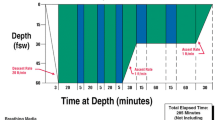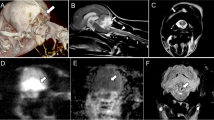Abstract
Scuba diving is associated with risk of severe decompression sickness (DCS type II), which results from rapid reduction of the environmental pressure sufficient to cause the formation into tissue or blood of inert gas bubbles previously loaded within tissues as a soluble phase. DCS type II constitutes a unique subset of ischemic insults to the central nervous system (CNS) with primarily involvement of the spinal cord. Ten patients with diving-related barotrauma underwent neurologic examination. Two of them presented progressive sensory and motor loss in the extremities at admission and were presumed affected by spinal cord DCS. Magnetic resonance imaging (MRI) demonstrated abnormalities in the white-matter tracts of the spinal cord in these patients, in each case corresponding to an area of the cord believed to be clinically involved. After a course of therapeutic recompressions, one patient was able to stand and walk a short distance,and MRI revealed a decreased extension of areas of spinal cord abnormalities. MRI has proved to be reliable in the detection of pathologic changes of spinal cord decompression sickness that were previously undetectable by other neuroimaging methods and also has proved to be useful in the follow-up during therapeutic hyperbaric recompressions.
Similar content being viewed by others
References
Faralli F (1996) Decompression illness. InHandbook on Hyperbaric Medicine (Oriani G, Marroni A, Wattel F, eds.) pp. 135–182. Berlin: Springer-Verlag.
Ahron-Peretz J, Adir Y, Gordon CR, Kol S, Gal N, Melamed Y (1993) Spinal cord decompression sickness in sport diving.Arch Neurol 50: 753–756.
Hallenbeck JM, Bove AA, Elliot DH, Phil D (1975) Mechanism underlying spinal cord damage in decompression sickness.Neurology 25: 308–316.
Zwirewich CV, Müller NL, Abboud RT, Lepawsky M (1987) Noncardiogenic pulmonary edema caused by decompression sickness: rapid resolution following hyperbaric therapy.Radiology 163: 81–82.
Harris JB, Stern EJ, Steinberg KP (1995) Scuba diving accident with near drowning and decompression sickness.AJR Am J Roentgenol 164: 592.
Warren JP, Djang WT, Moon RE, Camporesi EM, Skipp Salle D, Anthony DC, Massey EW, Burger PC, Heinz ER (1988) Neuroimaging of scuba diving injuries to the CNS.AJR Am J Roentgenol 151: 1003–1008.
Hodgson M, Beran RG, Shirtley G (1988) The role of computed tomography in the assessment of neurologic sequelae of decompression sickness.Arch Neurol 45: 1033–1035.
Kizer KW (1981) The role of computed tomography in the management of dysbaric diving accidents.Radiology 140: 705–707.
Levin HS, Goldstein FC, Norcross K, Amparo EG, Guinto FC, Mader JT (1989) Neurobehavioral and magnetic resonance imaging findings in two cases of decompression sickness.Aviat Space Environ Med 60: 1204–1210.
US Navy (1985)US Navy Diving Manual. NAVSEA 0994-LP-001-9010. pp. 8–36. Washington, DC: Department of Defense.
Dick APK, Massey EW (1985) Neurologic presentation of decompression sickness and air embolism in sport divers.Neurology 35: 667–671.
Sykes JJW, Yaffe LJ (1985) Light and electron microscopic alterations in spinal cord myelin sheaths after decompression sickness.Undersea Biomed Res 12: 251–258.
Calder IM, Palmer AC, Hughes JT (1987) Spinal cord damage found at autopsy in divers.EUBS 87, Diving and Hyperbaric Medicine: Proceedings of the XIIIth Annual Meeting of the European Undersea Biomedical Society, Palermo, Italy, pp. 310–314.
Author information
Authors and Affiliations
Rights and permissions
About this article
Cite this article
Sparacia, G., Banco, A., Sparacia, B. et al. Magnetic resonance findings in scuba diving-related spinal cord decompression sickness. MAGMA 5, 111–115 (1997). https://doi.org/10.1007/BF02592241
Received:
Accepted:
Issue Date:
DOI: https://doi.org/10.1007/BF02592241




